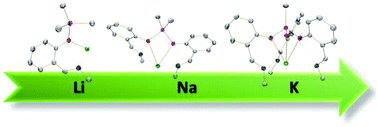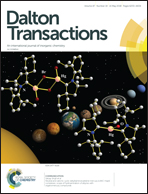Schiff-base -ate derivatives with main group metals: generation of a tripodal aluminate metalloligand†
Abstract
New heterobimetallic aluminates with well-defined structures bearing bidentate Schiff bases as ligands have been prepared. The ligands studied are PhO–CH![[double bond, length as m-dash]](https://www.rsc.org/images/entities/char_e001.gif) N–Ar (Ar = C6H5 (La) and 2,6-iPr-C6H3 (Lb)), with and without donor substituents in the ortho position of the arene ring bonded to the iminic nitrogen. To prepare the heterometallic species, the HL proligands were treated with the appropriate alkali metal precursor and then AlMe3 was added. In these reactions the alkali metal size has a substantial influence on the outcome. For lithium, the formation of [LiAlMe3(L)]21(a–b) compounds was straightforward and their nuclearity in the solid state was confirmed by X-ray studies. When moving to sodium, the analogous species [NaAlMe3(L)]n initially formed, quickly evolved to [NaAlMe2(L)2]n3(a–b) in solution. As well, for potassium, the initial derivatives formed [KAlMe3L] progressed very rapidly to the generation of [KAlMe2L2] as evidenced from the isolation of [KAlMe2(Lb)2] 4b as a crystalline product. Furthermore, for potassium the unique species [KAlMe(Lb)3] 5b was isolated which shows, as a striking feature, the presence of an unusual tripodal metalloligand.
N–Ar (Ar = C6H5 (La) and 2,6-iPr-C6H3 (Lb)), with and without donor substituents in the ortho position of the arene ring bonded to the iminic nitrogen. To prepare the heterometallic species, the HL proligands were treated with the appropriate alkali metal precursor and then AlMe3 was added. In these reactions the alkali metal size has a substantial influence on the outcome. For lithium, the formation of [LiAlMe3(L)]21(a–b) compounds was straightforward and their nuclearity in the solid state was confirmed by X-ray studies. When moving to sodium, the analogous species [NaAlMe3(L)]n initially formed, quickly evolved to [NaAlMe2(L)2]n3(a–b) in solution. As well, for potassium, the initial derivatives formed [KAlMe3L] progressed very rapidly to the generation of [KAlMe2L2] as evidenced from the isolation of [KAlMe2(Lb)2] 4b as a crystalline product. Furthermore, for potassium the unique species [KAlMe(Lb)3] 5b was isolated which shows, as a striking feature, the presence of an unusual tripodal metalloligand.



 Please wait while we load your content...
Please wait while we load your content...